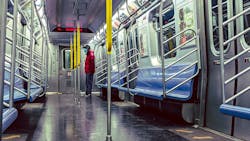Editor's Notebook: Welcome back to a different world
he COVID-19 pandemic is proving to be one of the greatest disruptors experienced in generations. Most locations in North America have entered a phased reopening with new limits on restaurants and other retail businesses. Some of us may still be working from home full time; some company travel restrictions, while eased, may not have been lifted completely and, for those of us with school-aged children at home, e-learning has concluded (thankfully).
For transit, the disruption has spread to every corner and has impacted the very basis of what the industry provides. For an industry that prides itself on being one of the safest modes of travel, its jarring to have riders question the safety of transit based on how close they may physically be to other people.
Short-term efforts by agencies across North America will focus on making riders and employees feel safe when they enter a transit system. All agencies have ramped up cleaning protocols and service levels are beginning to increase to support social distancing guidelines.
New York Metropolitan Transportation Authority (MTA) Chief Innovation Officer Mark Dowd said the pandemic has created opportunities for new technologies to solve once-in-a-generation challenges. MTA is piloting a sanitization system using ultraviolet (UV) light on its subways, buses and facilities. The Central Ohio Transit Authority is disinfecting its vehicles with a microbe shield that is applied once a year and works by attracting and then electrocuting and rupturing a microbe’s negatively charged cell membrane. Kind of gross, but also kind of cool.
A less high-tech, but still innovative solution is Bay Area Rapid Transit’s plan to hand out personal hand straps to its riders. The straps can be used to travel and then can be brought home for sanitization purposes.
The simple yet effective technique of keeping one’s hands clean is being encouraged on systems, as well. San Diego Metropolitan Transit System has installed hand washing units at all 53 Trolley stations, plus the UTC Transit Center, and hand sanitizer dispensers have been installed on various systems including TriMet and Miami-Dade Transit.
There will be many bumpy spots on the road to recovery, but the industry’s level of commitment to making riders feel safe is providing a good framework on which to build a better future for when transit can welcome back the masses.
About the Author

Mischa Wanek-Libman
Group Editorial Director
Mischa Wanek-Libman is director of communications with Transdev North America. She has more than 20 years of experience working in the transportation industry covering construction projects, engineering challenges, transit and rail operations and best practices.
Wanek-Libman has held top editorial positions at freight rail and public transportation business-to-business publications including as editor-in-chief and editorial director of Mass Transit from 2018-2024. She has been recognized for editorial excellence through her individual work, as well as for collaborative content.
She is an active member of the American Public Transportation Association's Marketing and Communications Committee and served 14 years as a Board Observer on the National Railroad Construction and Maintenance Association (NRC) Board of Directors.
She is a graduate of Drake University in Des Moines, Iowa, where she earned a Bachelor of Arts degree in Journalism and Mass Communication.
